
The Scottish dirk is a unique and important weapon that has played a significant role in Scottish history and culture. Its design and function have evolved over the centuries, from a simple utility knife to a deadly weapon used in battle and single combat. Today, the dirk remains a symbol of Scottish heritage and identity, and it continues to be a beloved and revered part of Scottish culture.
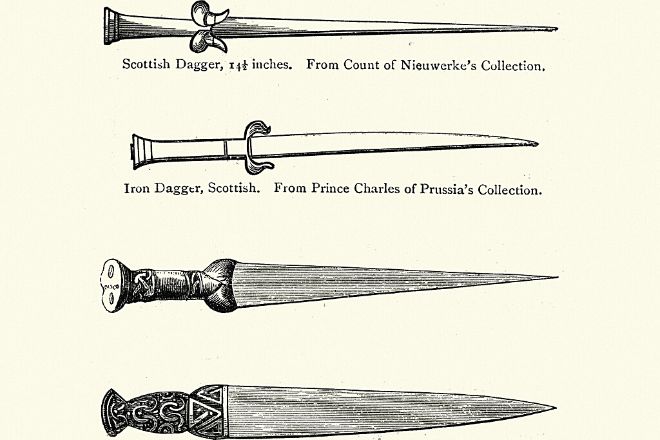
The Scottish dirk has a rich history in Scottish culture, evolving from a utility knife to a formidable weapon used in battle and single combat. Its unique design, including the basket hilt and broad, double-edged blade, is a distinctive feature. The dirk remains a symbol of Scottish identity and heritage, often worn as part of traditional Highland dress and used in important ceremonies.
The dirk also has practical uses today, including as a hunting knife and tool for outdoor activities. The Scottish dirk is a remarkable and important part of Scottish history and culture, appreciated by collectors and enthusiasts for its beauty and craftsmanship.
The Scottish dirk is a beautiful and functional weapon made of high-carbon steel, with a double-edged blade perfect for thrusting and slashing. Its hilt is made of wood and metal, with a distinctive basket hilt for maximum flexibility and protection. The pommel is adorned with a decorative jewel and provides balance and grip for precision and control in combat. The Scottish dirk remains popular today for outdoor activities and as a historical art piece, standing the test of time with its unique design and cultural significance.
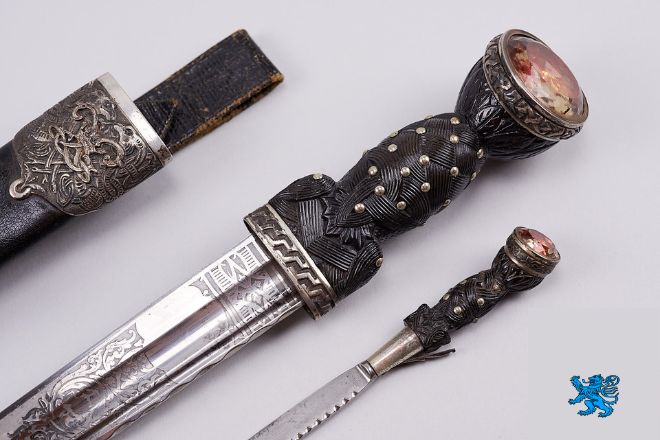
The Highland dirk is a significant Scottish weapon, evolving over time to reflect its diverse uses. Originally a close combat weapon for Highland warriors during the Jacobite risings, it was also utilized for hunting, fishing, and cutting through dense vegetation. Typically measuring between 12-18 inches with a single-edged blade tapering to a point, the hilt was often decorated with intricate designs, precious metals, and gemstones as a display of wealth and status. Beyond its combat use, the dirk’s sharp blade made it ideal for hunting and fishing, while its design made it perfect for cutting through dense vegetation.
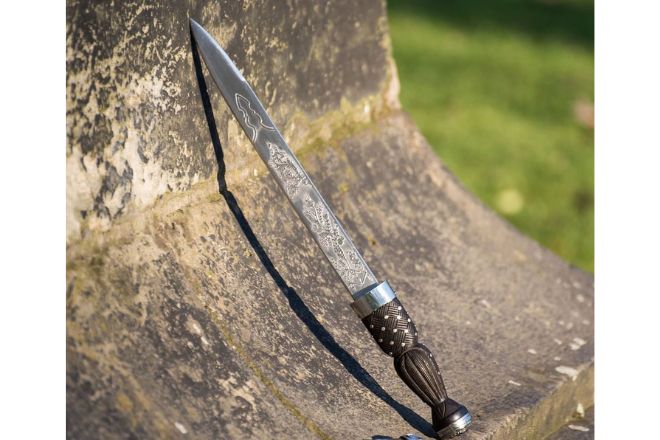
Today, the Highland dirk remains a crucial part of Scottish culture and tradition, used in events such as weddings and funerals. Its rich history and decorative features make it popular among collectors, with many antique dirks available for purchase. The Highland dirk also symbolizes Scotland’s complex and tumultuous history, representing a time of political upheaval and conflict while embodying the resilience and determination of the Scottish people.
Wearing the Highland dirk is an important part of Scottish Highland dress or of Kilt attire, and there is a traditional way to do it. The dirk is worn on the right hip with the handle facing forward. To secure it in place, a leather sheath is attached to a fabic or leather belt which mostly gets associated with kilt outfits and known as the Kilt Belt. The Highland dirk is not the only item in a traditional Scottish Highland dress outfit.
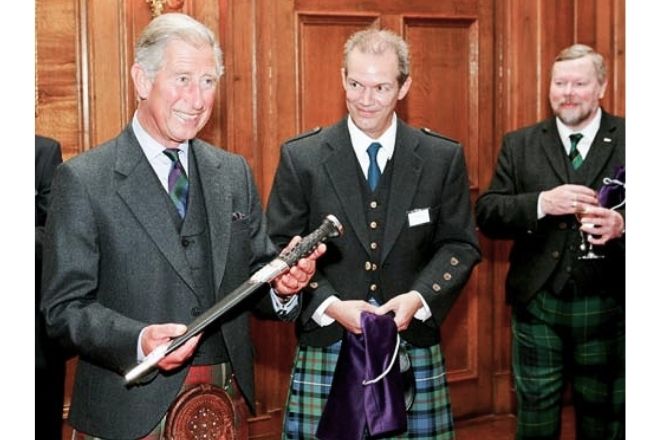
A kilt, sporran, jacket, and ghillie brogues are also essential components. The kilt is a knee-length garment made of tartan fabric, and the Sporrans are small pouches that are worn around the waist. The jacket is typically a tweed or wool garment with a high collar, while Ghillie brogues are traditional Scottish shoes with laces that wrap around the ankles. and Along with other items of Scottish Highland dress, the Highland dirk represents a unique and enduring cultural heritage that continues to be celebrated today.
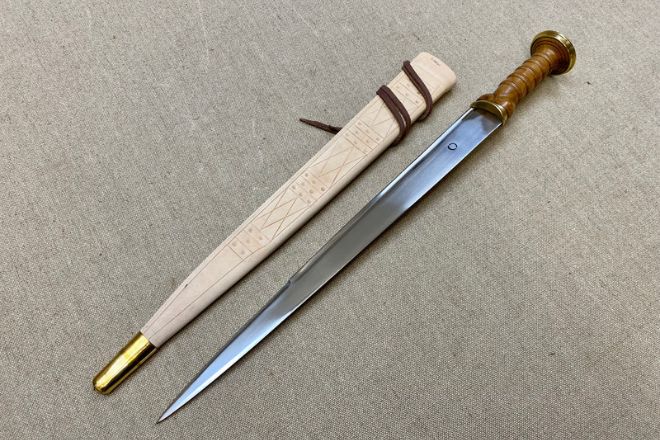
The Scottish dirk is a symbol of Scottish identity and heritage that has appeared in art, literature, and popular culture. It has been used by famous Scottish figures throughout history and is often associated with bravery, honor, and loyalty. The dirk has also been the subject of myths and legends, such as its association with Scottish assassins known as “sgian-dubh.” Despite the inaccuracies of these myths, the Scottish dirk remains an important part of Scottish culture and a symbol of the country’s enduring spirit.
The dirk has historically been employed as a symbol of affluence, prestige, and elegance, and even now serves as an ornamental item for ceremonial purposes. Presently, it is primarily worn by Scottish Highland regiment officers. The Bagpipers Attire, Nonetheless, some men may opt to wear it as an accessory during fraternal gatherings, The Scottish Royal Wedding, or other events that highlight their presence, such as delivering the Address to a Haggis at a Burns Supper.
The dirk (Gaelic: Biodag) is a long-standing personal sidearm and a versatile tool that has been a part of Scottish history and culture for centuries. Originally a practical knife for the field and a hunting knife, it evolved into a formidable weapon. Often confused with the smaller utility knife called the Sgian Dubh, the traditional form of the Highland dirk developed from the Bollock Dagger of the Renaissance era. While some early dirks were double-edged, the single-edge design prevailed with an average blade length of 12″.
The hilt, usually carved from a hard wood like oak, featured knotwork carvings and studs for improved grip. Over the centuries, the hilt design changed from the ballock type to a cylindrical form with a flat pommel borrowed from the Rondel dagger. This provided a surer grip, especially when holding the knife blade-down in combat while also carrying a Targe (the scottish weapon). The dirk remains a symbol of Scottish identity and heritage, often worn as part of traditional Highland dress, and it also has practical uses today.
While both weapons are designed for close-quarters combat, the Scottish dirk is typically larger and heavier than a dagger, with a broader blade and a basket hilt for protection.
It is legal to own a Scottish dirk in Scotland, but it is illegal to carry one in public without a reasonable excuse, such as wearing it as part of traditional Highland dress.
While the Scottish dirk is no longer used as a weapon in modern combat, it remains a symbol of Scottish identity and heritage and is often worn as part of traditional Highland dress.
A seax knife is a type of single-edged blade that was commonly used by Germanic peoples during the Viking Age and early Middle Ages.
No, a Scottish dirk is a single-edged dagger, often with a decorative or ornamental hilt, that originated in Scotland in the 17th century and was traditionally worn as part of Highland dress.
Input your search keywords and press Enter.
